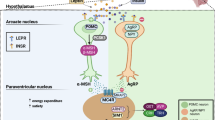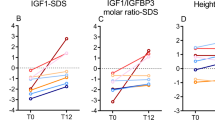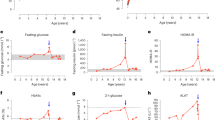Abstract
The extreme obesity of the obese (ob/ob) mouse is attributable to mutations in the gene encoding leptin1, an adipocyte-specific secreted protein which has profound effects on appetite and energy expenditure. We know of no equivalent evidence regarding leptin's role in the control of fat mass in humans. We have examined two severely obese children who are members of the same highly consanguineous pedigree. Their serum leptin levels were very low despite their markedly elevated fat mass and, in both, a homozygous frame-shift mutation involving the deletion of a single guanine nucleotide in codon 133 of the gene for leptin was found. The severe obesity found in these congenitally leptin-deficient subjects provides the first genetic evidence that leptin is an important regulator of energy balance in humans.
This is a preview of subscription content, access via your institution
Access options
Subscribe to this journal
Receive 51 print issues and online access
$199.00 per year
only $3.90 per issue
Buy this article
- Purchase on SpringerLink
- Instant access to full article PDF
Prices may be subject to local taxes which are calculated during checkout



Similar content being viewed by others
References
Zhang, Y. et al. Positional cloning of the mouse obese gene and its human homologue. Nature 372, 425–432 (1994).
Maffei, M. et al. Increased expression in adipocytes of ob RNA in mice with lesions of the hypothalamus and with mutations at the db locus. Proc. Natl Acad. Sci. USA 92, 6957–6960 (1995).
Stephens, T. W. et al. The role of neuropeptide Y in the antiobesity action of the obese gene product. Nature 377, 530–534 (1995).
Vaisse, C. et al. Leptin activation of Stat3 in the hypothalamus of wild type and ob/ob mice but not db/db mice. Nature Genet. 14, 95–97 (1996).
Pelleymounter, M. A. et al. Effects of the obese gene product on body weight regulation in ob/ob mice. Science 269, 540–543 (1995).
Halaas, J. L. et al. Weight-reducing effects of the plasma protein encoded by the obese gene. Science 269, 543–546 (1995).
Campfield, L. A., Smith, F. J., Guisez, Y., Devos, R. & Burn, P. Recombinant mouse ob protein: Evidence for a peripheral signal linking adiposity and central networks. Science 269, 546–549 (1995).
Chen, G. et al. Disappearance of body fat in normal rats induced by adenovirus-mediated leptin gene therapy. Proc. Natl Acad. Sci. USA 93, 14795–14799 (1996).
Maffei, M. et al. Absence of mutations in the human ob gene in obese/diabetic subjects. Diabetes 45, 679–682 (1996).
Considine, R. V. et al. Evidence against either a premature stop codon or the absence of obese gene mRNA in human obesity. J. Clin. Invest. 95, 2986–2988 (1995).
Bouchard, C. The causes of obesity: advances in molecular biology but stagnation on the genetic front. Diabetologia 39, 1532–1533 (1996).
Maffei, M. et al. Leptin levels in human and rodent, measurement of plasma leptin and ob RNA in obese and weight-reduced subjects. Nature Med. 1, 1155–1161 (1995).
Zhang, F. et al. Crystal structure of the obese protein leptin-E100. Nature 387, 206–209 (1997).
Krawczak, M., Reiss, J. & Cooper, N. The mutational spectrum of single base-pair substitutions in mRNA splice junctions of human genes: causes and consequences. Hum. Genet. 90, 41–54 (1992).
York, D. A., Otto, W. & Taylor, T. G. Thyroid status of obese (ob/ob) mice and its relationship to adipose tissue metabolism. Comp. Biochem. Physiol. 590, 59–65 (1978).
Coleman, D. L. Obesity genes: beneficial effects in heterozygous mice. Science 203, 663–665 (1979).
Ravussin, E. et al. Relatively low plasma leptin concentrations preceed weight gain in Pima Indians. Nature Med. 3, 238–240 (1997).
Chehab, F. F., Mounzih, K., Lu, R. & Lim, M. E. Early onset of reproductive function in normal female mice treated with leptin. Science 275, 88–90 (1997).
Ahima, R. S. et al. Role of leptin in the neuroendocrine response to fasting. Nature 382, 250–252 (1996).
Garrow, J. S. & Webster, J. Quetelet's Index (W/H2) as a measure of fatness. Int. J. Obes. 9, 147–153 (1985).
Fomon, S. J., Haschke, F., Ziegler, E. E. & Nelson, S. E. Body composition of reference children from birth to age 10 years. Am. J. Clin. Nutr. 35, 1169–1175 (1982).
Acknowledgements
We thank S. Jebb for help with analysis of body composition; C. N. Hales, S. Kumar, A. Kelly and P. Raggett for access to control samples; A. Roberts for help with clinical studies; M.McCaleb, F. Martin, N. Hernday, C. N. Hales, A. Krook, S. Jebb, A. Prentice and N. Finer for discussions; T. M. Cox, V. K. K. Chatterjee and P. Luzio for reading the manuscript; and M. Flint for secretarial assistance. This research was supported by grants from the Wellcome Trust, the British Diabetic Association and a Medical Research Council (UK) studentship to C.T.M. H.R. is supported by the TMR programme of the EC.
Author information
Authors and Affiliations
Corresponding author
Additional information
Correspondence and requests for materials should be addressed to S.O.R. (e-mail: sorahill@hgmp.mrc.ac.uk)
Rights and permissions
About this article
Cite this article
Montague, C., Farooqi, I., Whitehead, J. et al. Congenital leptin deficiency is associated with severe early-onset obesity in humans. Nature 387, 903–908 (1997). https://doi.org/10.1038/43185
Received:
Accepted:
Issue Date:
DOI: https://doi.org/10.1038/43185



